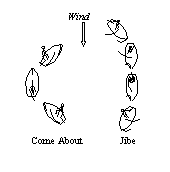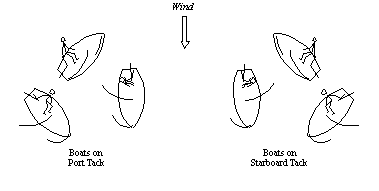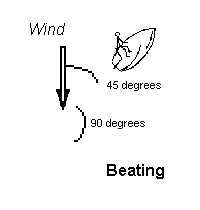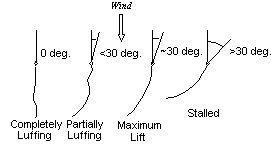![]()
Introductory Handbook
for Sailing Boats
SAILING BASICS
Directions
A sailboat's course is the direction it is heading.
The skipper usually sits on the windward (upwind) side of the boat, and the sails are on the leeward (downwind, pronounced lew' ard) side.
The wind direction is named for its source. A west wind comes from the west.
Heading Up and Falling Off
Heading up means turning toward the wind, so the boat is pointed more toward the direction the wind is coming from.
Falling off, the opposite of heading up, means turning away from the wind.
Coming About and Jibing

Coming about and jibing are the two ways of turning a sailboat so that the sails switch from one side to the other.
Coming about (also called tacking) means heading up, briefly pointing toward the wind during the turn, and falling off until the boat is sailing again. The sails will flap their way across the boat as it turns.
Jibing means falling off, pointing away from the wind, and causing the sail to be flipped across the boat. The safest way to jibe is to pull the sail across to the middle while pointing directly away from the wind, then let it out to the other side.
Port and Starboard Tacks

Port and starboard tacks, critical to right of way rules, refer to which side the mainsail is on. The port side of the boat is the left one when you are facing forward, and starboard the right. On a port tack, the wind is coming from the port side or from behind the boat (unless you're by the lee) and the mainsail is on the starboard side.
Right of Way Rules
The government right of way rules apply between windsurfers as well as sailboats when there are no docks, rocks, or other obstructions to hamper maneuvering. In order of priority, the rules are:
1) When one boat (or windsurfer) is overtaking another, the slower one has right of way.
2) When the two boats are on different tacks; the one on starboard tack has right of way.
3) If both boats are on the same tack, the leeward (downwind) boat has right of way.
If you have right of way, hold your course and signal the other boat. If they don't respond, change your course to avoid the collision.
Collision Courses
Check frequently for other boats or windsurfers coming your way, and always do so before coming about, jibing, or turning suddenly. A boat or windsurfer coming at you is on a collision course if it appears to stay in a fixed position relative to an object or landmark on the horizon.
Points of Sail
 Points of sail are names for the angle between a sailboat and the wind.
Points of sail are names for the angle between a sailboat and the wind.
In irons means the boat is pointed directly into the wind (an angle of 0 degrees).
Close hauled means the boat is pointed at about 45 degrees to the wind.
The fastest way to get directly upwind is to sail closehauled, coming about in 90 degree turns to switch direction.
 Zigzagging upwind in this manner is called beating, possibly because of the wind and spray suffered by the crew in heavy weather (high
winds and waves).
Zigzagging upwind in this manner is called beating, possibly because of the wind and spray suffered by the crew in heavy weather (high
winds and waves).
A close reach is any upwind course at an angle between about 45 and 90 degrees. A beam reach is when the wind direction is at about 90 degrees to the boat's direction of travel.
A broad reach is more than 90 degrees and less than about 135 (=90+45) degrees.
A run is when the wind is behind the boat. A dead run is sailing straight downwind.
By the lee is when the wind is coming from the same side of the boat that the sail is on. Sailing by the lee can be dangerous, since if the boat turns farther or if the wind shifts direction, the boat will accidentally jibe when the wind catches the back side of the sail.
Sail Trim
 The power from sails depends on the angle between the wind and the sail. Sail trim is the adjustment of that angle.
The power from sails depends on the angle between the wind and the sail. Sail trim is the adjustment of that angle.
To go upwind or across the wind, a boat must get lift from its sails. Sails develop the most lift at an angle of about 30 degrees to the wind blowing across the boat1. To go downwind, the wind pushes the sails, and they develop maximum power when let out all the way.
When a sail is not pulled in at an angle to the wind, it flaps in the wind like a flag. In sailing terminology, it is completely luffing.
As the sail is pulled in, it becomes partly luffing: the back part takes on a curved shape, while the front part (near the mast or forestay) continues to flutter or retain a bubble-like indentation.
At an angle of about 30 degrees to the wind direction across the boat, the sail is full and develops maximum lift. At angles greater than 30 degrees, the sail is stalled. The wind pushes on the sail, but does not create much lift.
Both steering and the sheets (lines to adjust the sail's position) affect sail trim. If a sail is luffing, it can usually be filled by either pulling in its sheet or falling off. If it's stalled, either let out the sheet or head up slightly until it starts to luff, then pull it in or fall off until it's full.
To get the most force out of a sail when on a close haul, close reach, or beam reach, pull it in (or fall off) until it just stops luffing. On a broad reach or run, let out the sail as far as it will go.
Telltales are yarn streamers attached to the shrouds and jib. The shroud telltales (on the wires that hold up the mast) are useful for judging the direction of the wind blowing across the boat.
The jib telltales (sewn through the jib) provide a sensitive indication of sail trim. When both jib telltales stream back, the jib is at the proper angle to the wind for maximum lift. When the windward (near) telltale flutters, the jib is starting to luff; when the leeward (far) telltale flutters, the jib is starting to stall.
*1 also called apparent wind, since it is influenced by the boat's speed.





